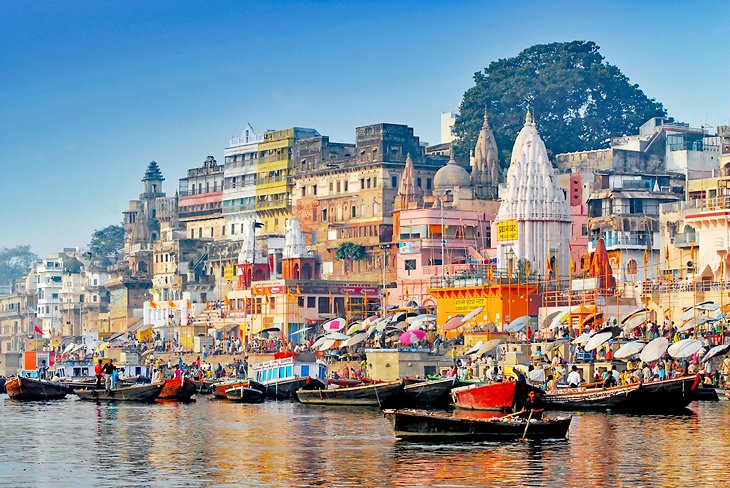For millions of pilgrims and visitors, Varanasi—one of the oldest living towns on Earth—is a spiritual refuge. Tucked down along the holy Ganges River, this historic city is well-known for its ghats, rich culture, and particularly for its temples. Often regarded as India’s spiritual capital, Varanasi is defined in great part by its temples. Beginning with the most revered of them all, the Kashi Vishwanath Temple, let us explore the Temples in Varanasi.
Temples in Varanasi
There are a lot of temples in Varanasi. Let’s take a look at them:
-
Kashi Vishwanath Temple
Not only the most well-known temple in Varanasi but also among the most important in Hinduism is the Kashi Vishwanath Temple, devoted to Lord Shiva. Often referred to as the Golden Temple because of its gold-plated tower, it represents spiritual enlightenment and release. The temple’s history goes back millennia; its present form was constructed by Indore’s Maratha king, Maharani Ahilya Bai Holkar, in 1780.
One of the twelve famous manifestations of Shiva, the temple complex holds the Jyotirlinga. Pilgrims say that a visit to this temple and a dip in the sacred Ganges can produce moksha—that is, release from the cycle of rebirth. An amazing spiritual experience is created by the temple’s little pathways, crowded with devotees, and a vivid atmosphere around it.
-
Sankat Mochan Hanuman Temple
Another main spiritual landmark in Varanasi is the Sankat Mochan Hanuman Temple, dedicated to Lord Hanuman. Goswami Tulsidas, the well-known saint, was the author of the Ramcharitmanas and started it in the sixteenth century. It is thought that the temple helps visitors overcome their problems and suffering. The temple has a notable number of devotees every Tuesday and Saturday who come to seek blessings and pray to Hanuman, the monkey god renowned for his unflinching loyalty to Lord Rama.
Amid the Hanuman Chalisa chanting and marigold aroma, the temple’s calm environment offers tranquility and dedication to everyone who visits.
-
Durga Temple
Dedicated to Goddess Durga, the personification of feminine power. The Durga Temple is also known as the Monkey Temple because of the abundance of monkeys in its surroundings. Constructed by Bengali Maharani in the 18th century, the temple is unique in its bright red color, which speaks for the goddess’s heroism and might.
With its multicolored spires, the temple’s architecture is a superb illustration of the North Indian Nagara style. Particularly during Navratri, devotees swarm here to honor the goddess and ask her blessings for protection and strength.
-
Tulsi Manas Temple
Built in 1964, the Tulsi Manas Temple is somewhat modern compared to Varanasi’s historic temples, yet it is of great importance. It is dedicated to Lord Rama and takes place at the location where the Hindi version of the Ramayana, the Ramcharitmanas, was created. The temple is a spiritual and literary monument with scenes from this epic adornment on its walls.
The white marble construction radiates peace and purity, and the quiet gardens around the temple offer ideal surroundings for devotion and introspection.
-
New Vishwanath Temple
Built by the Birla family, eminent industrialists, and benefactors, the New Vishwanath Temple. Sometimes known as the Birla Mandir, is housed on the grounds of Banaras Hindu University (BHU). Dedicated to Lord Shiva, the temple copies the design of the first Kashi Vishwanath Temple.
Rising majestically with its complex sculptures and large courtyards, the temple is an architectural wonder. It offers a peaceful setting for both guests and students, therefore harmonizing spirituality with knowledge.
-
Temple of Bharat Mata
Dedicated not to a deity but to Mother India. The Bharat Mata Temple is among the most unusual temples in Varanasi. Built-in the direction of Mahatma Gandhi in 1936, the shrine features a marble relief map of indivisible India. For individuals who want to honor the country, it is a major monument since it stands for togetherness and patriotism.
Conclusion
The temples in Varanasi provide a deep window into the spiritual core of the city. Every temple, from the distinctive Bharat Mata Temple to the old Shiv Kashi Vishwanath Mandir, has a narrative, past, and meaning. Visiting these temples explores India’s rich cultural and spiritual legacy in addition to a path of faith. The Varanasi temples offer a haven of calm and illumination regardless of your search for divine favors, spiritual comfort, or just a better awareness of India’s historical customs.






